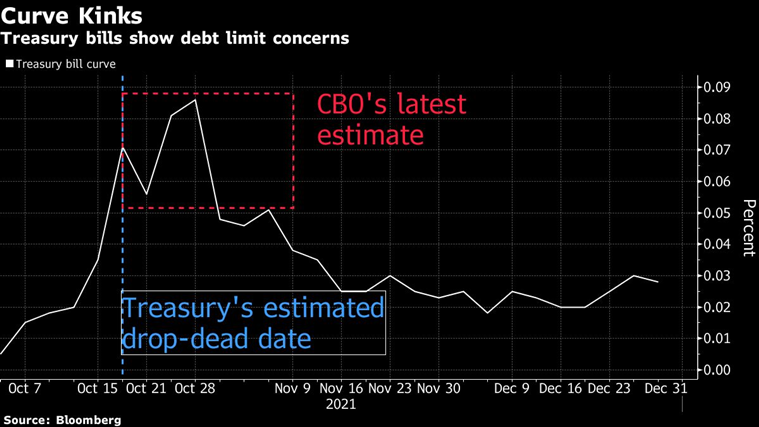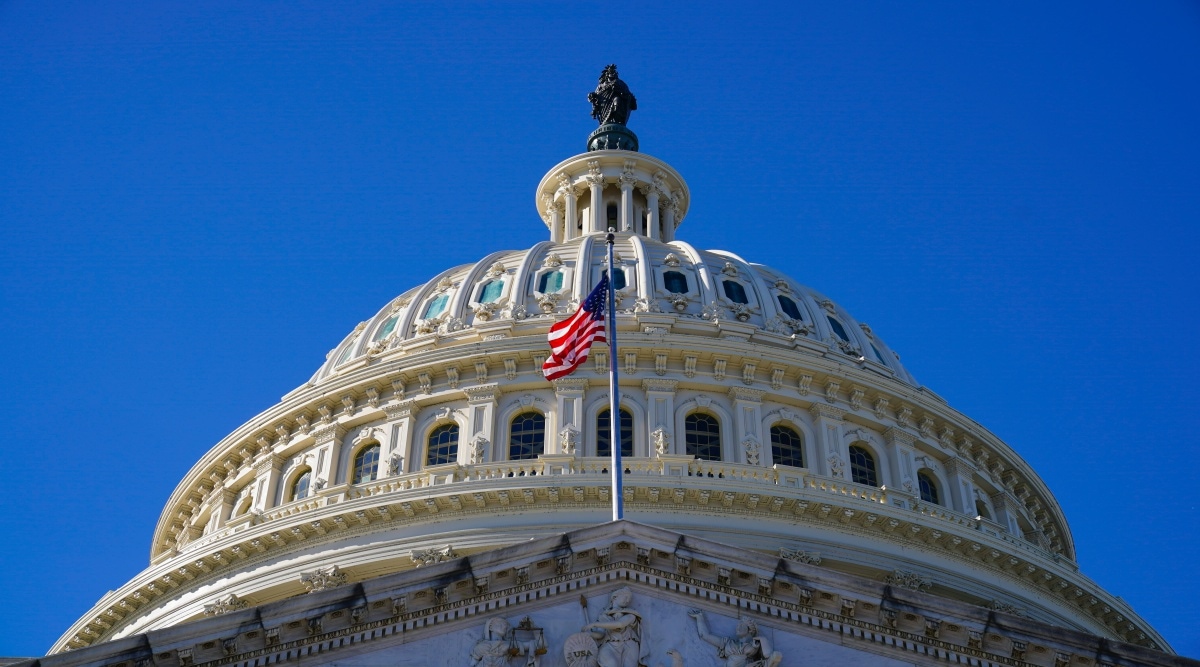
[ad_1]
The US is moving closer to its first-ever default, with neither political party in Washington yet signalling it’s ready to back down from a partisan showdown on the federal debt limit.
Senate Democratic Leader Chuck Schumer plans another vote as early as Monday on a measure passed by the House to suspend the federal government’s legal debt limit until December 2022. But his Republican counterpart, Mitch McConnell, vows to block the attempt, for the third time running.
The risk is rising that political miscalculation and byzantine congressional procedures could tip the US into an outcome that practically no one on Wall Street or Washington expects. President Joe Biden plans to speak on Monday on the need for Congress to address the debt ceiling.
“The consensus (from clients to whom we speak) is that it just will not happen,” Barclays Plc analysts including Shawn Golhar, head of public policy research, wrote in a note. “But political schisms in Congress are stronger than they have been in a long time and battle lines more hardened.”
The list of uncertainties includes:
*The precise date the Treasury Department will run out of cash unless the debt ceiling is lifted or suspended; Secretary Janet Yellen has said around Oct. 18 but other observers see a week or two longer
*How seriously Democrats have ruled out using the convoluted budgetary process that Republicans are seeking to force them to use to boost the limit
*The date when it would no longer be possible for Democrats to use that budgetary process to stave off default, because of insufficient time remaining

“The worry has already begun, to be quite honest,” said Gennadiy Goldberg, senior US interest rates strategist at TD Securities. Without a clear legislative path by the end of this week, “I think the market would get very worried,” he said.
QuickTake: What’s the Debt Ceiling and Will the US Raise It?
Morgan Stanley analysts forecast that unless there is a resolution by next week, Treasury bills maturing in late October could “quickly” decline in value, they wrote in a note to clients late last week. On Friday, Treasury bills around the potential default window sold off, with the yield on the Oct. 21 maturity climbing as much as 8 basis points.
Even without a default, brinkmanship over the debt limit between Republicans and the Obama administration in 2011 provoked the first-ever downgrade in the US sovereign credit rating and contributed to a stock-market slide.
Balancing the danger are assurances leaders of both parties have made that they don’t want a default. And, each party has a fail safe available at any time. Just 10 Republican senators can join with Democrats to end a filibuster of the debt-ceiling legislation. Or all 50 Senate Democrats can unite in carving out an exception to the filibuster rule, so that the measure can pass with a simple majority vote.
It would take about two weeks to raise the debt ceiling through the “reconciliation” budget process, according to William Hoagland and Steven Bell, both former Republican staff directors for the Senate Budget Committee. That suggests Monday, Oct. 4, as the last day to comfortably follow the alternative process — if Yellen’s Oct. 18 date proves binding.
Yellen, however, suggested in testimony Thursday to a House committee the government might have “a few days” of extra cash left after the default deadline she set. The Congressional Budget Office last week estimated the default date as late October or early November. Morgan Stanley projected Oct. 28 as the likely default date in its analysis Thursday.
Fiscal Flow Chart
The economic impact of the pandemic and the flows of money from the coronavirus relief packages Congress has passed compound the difficulty in predicting the precise day-to-day flow of government revenue and payments, which is tricky under any circumstances.
 The U.S. Capitol as seen on Tuesday, Dec. 29, 2020, in Washington. (AP)
The U.S. Capitol as seen on Tuesday, Dec. 29, 2020, in Washington. (AP)
The timeline for following the cumbersome reconciliation process also isn’t certain, since it’s usually deployed for a budget process that works out over months and involves multiple steps by both the House and Senate. Though it provides an avenue to bypass a Senate filibuster, it does include time for debate and an unlimited “vote-a-rama” in which senators can offer undebatable amendments to a budget resolution.
“We’ve never used this process in this way before,” said Hoagland, who as a Senate aide was involved in 18 of the 21 reconciliation resolutions passed by Congress and is now a senior vice president at the Bipartisan Policy Center.
Both Schumer and House Speaker Nancy Pelosi said last week that reconciliation is a “nonstarter” because it could take too long. Senator Dick Durbin on Illinois, the No. 2 Democratic leader, told reporters that Schumer walked through the process for other Democrats behind closed doors and said it involves “three or four weeks of activity in the House and Senate,” assuming GOP lawmakers make extensive use of opportunities to delay.
‘Clumsy Efforts’
Bell, who has been managing or analyzing annual budgets since the reconciliation process was established in 1981, said he is “confident it could be done in two weeks, if Senator Schumer works the Senate seven days a week.”
McConnell also could provide cooperation to shorten that time frame further “by a couple of days,” though not much more, unless all 50 Republican senators agree, Bell said.
McConnell has made clear he doesn’t intend to back down from his demand that Democrats endure the time-consuming process.
“Clumsy efforts at partisan jams do not work,” he said on the Senate floor Thursday. “What works is when the majority accepts the reality of the situation.”
Holiday Complications
Democrats voted with Republicans three times during Donald Trump’s presidency to raise or suspend the debt limit to avoid default, despite opposing the 2017 Republican tax cuts that added to the debt.
While the approaching default date creates an extremely high-stakes deadline for lawmakers, lesser ones loom as well. The Senate is scheduled for a week-long Columbus Day recess that begins Oct. 11. The House is scheduled to be away without votes for two weeks starting Monday, Oct. 4.
“We still expect that the debt-ceiling impasse will ultimately be resolved, likely through reconciliation,” the Barclays team, including Jeffrey Meli and Ajay Rajadhyaksha, wrote in their note last week. “But, in our view, the risk of a breach is now greater than at any point over the past decade.”
[ad_2]
Source link